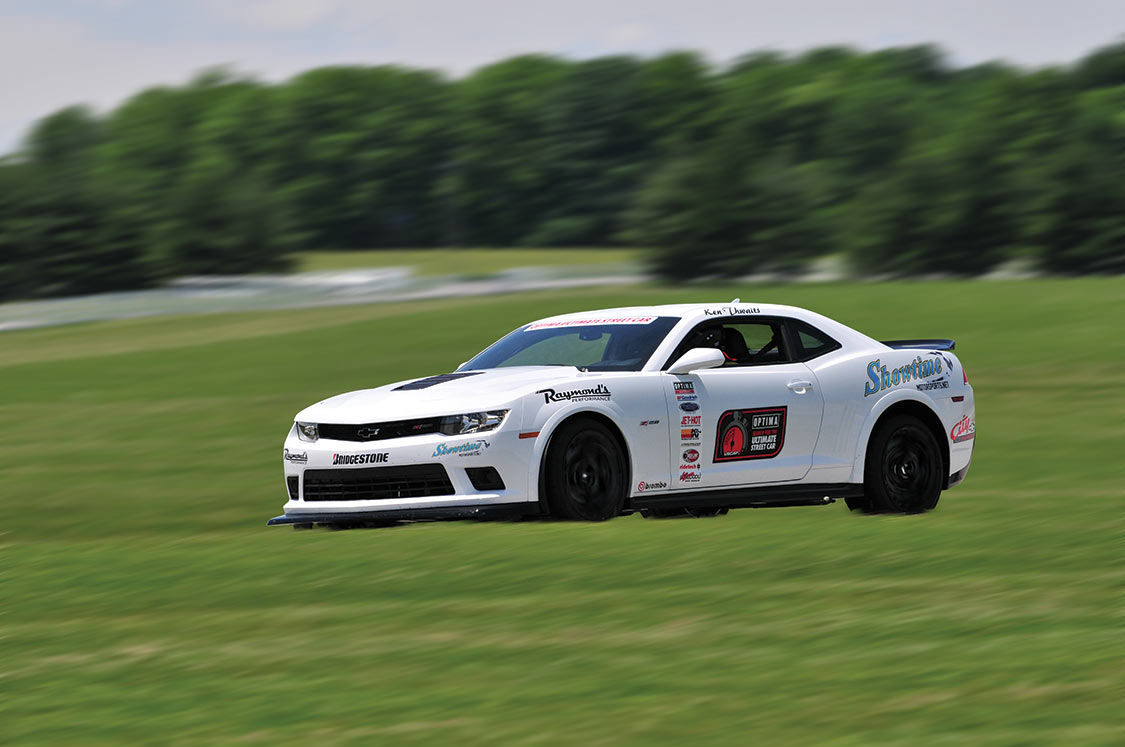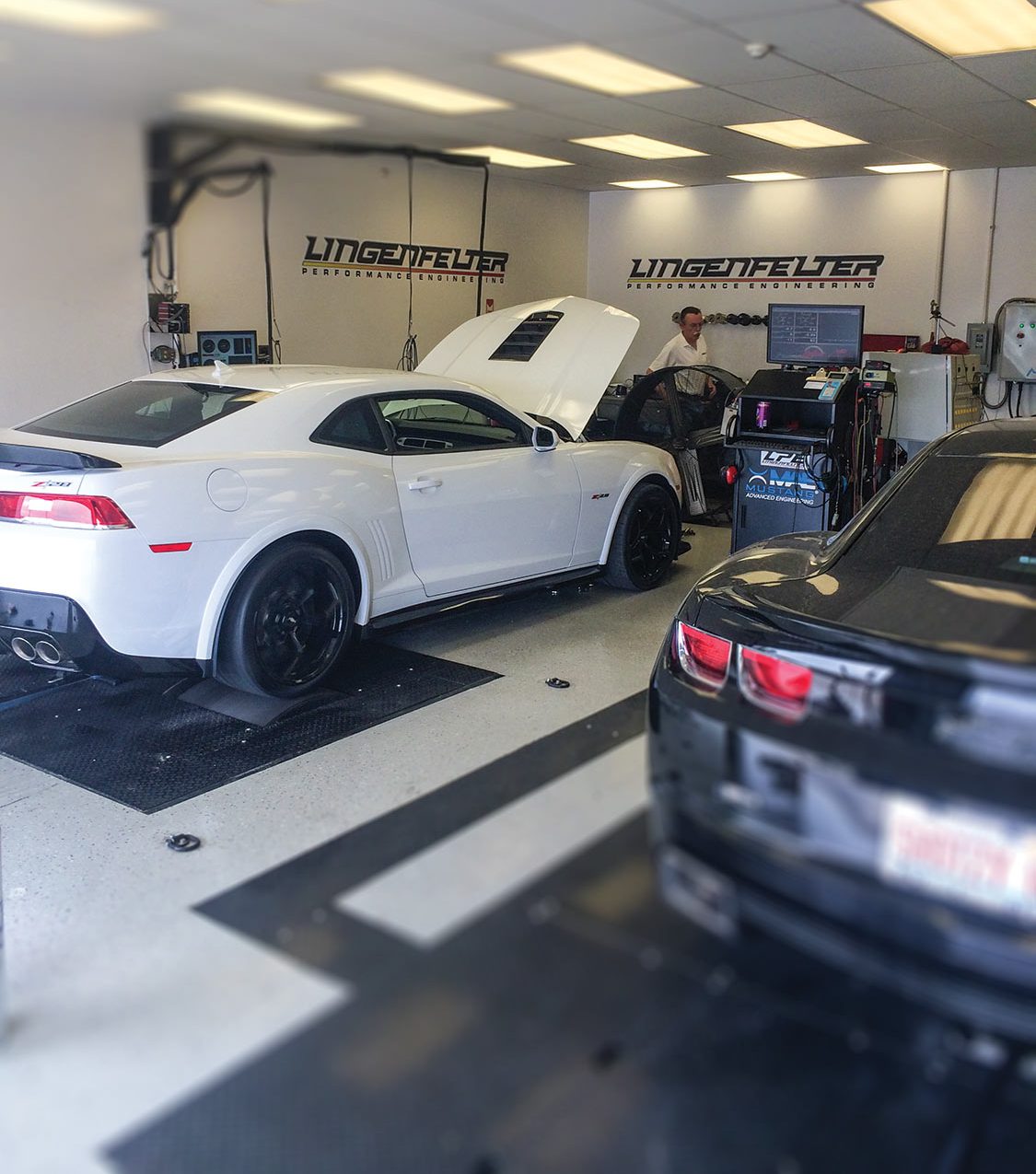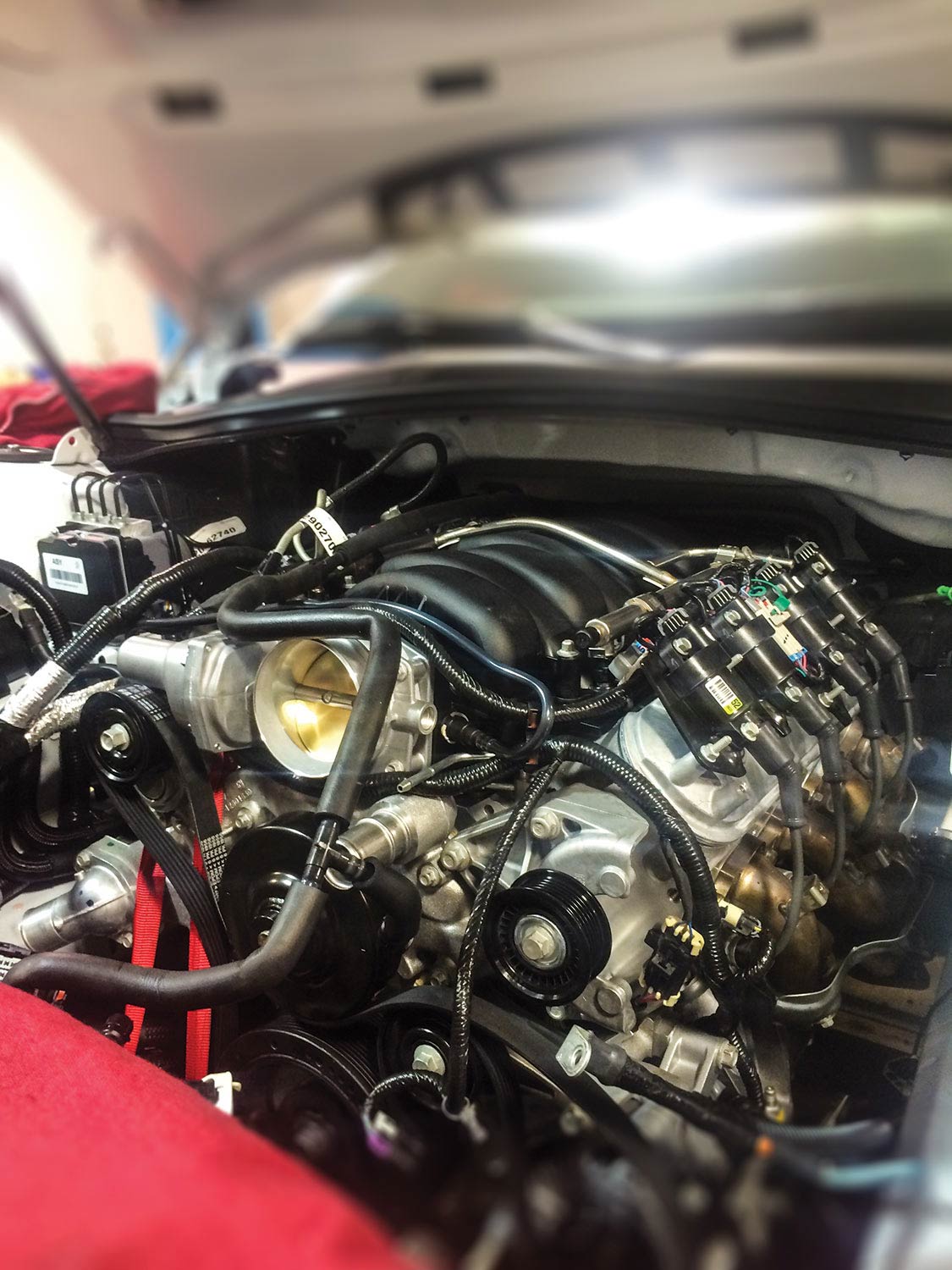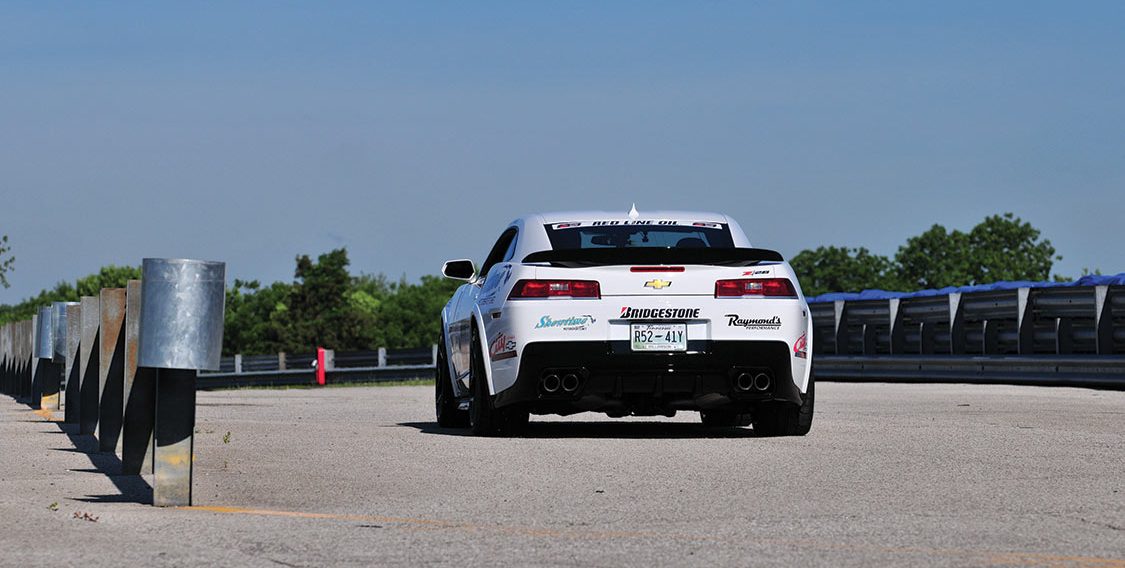Thomas Glatch May 31, 2022 All Feature Vehicles

It takes a serious performance automobile to break the top-100 lap times around the famed Nürburgring circuit, even more so the top 50. Deemed decades ago to be too dangerous for Formula 1, the 14.173-mile Nürburgring Nordschleife (North Course) undulates around Bavaria’s Black Forest
with a mix of long straightaways, tight turns, and suspension-pounding Flûgplatz (“flying place”) jumps. Three-time F1 champion Jackie Stewart called the track the “Green Hell,” and today manufacturers recognize the ’Ring as the ultimate performance development site as well as a marketing tool for their hottest cars. No surprise that most of the vehicles on the top-50 list are exotic, costly 2-seat supercars, but there amidst the times of such exotica as the Audi R8 GT, Porsche 911 Carrera S, McLaren Mercedes SLR and Lamborghini Murciélago LP640 is a conspicuous piece of Detroit iron: the 2014 Chevrolet Camaro Z/28.

The original Z/28 was more road-race bred than any 4-passenger American automobile at the time. Introduced in 1967, Regular Production Order Z28 was designed around the SCCA Trans-Am series. To compete in that popular series, entries had to be nearly “factory stock,” with the only safety equipment, racing tires and wheels added. Any part needed to help a vehicle’s performance required a factory part number and had to be homologated with the SCCA. That was the genesis of the Z/28, a stripped-down, hardcore road/track machine. As such, it came stock with heavy-duty suspension, fast-ratio steering and aerodynamic aids to make it nearly race ready. The original Z/28 also had a new high-revving 302-cu.-in. V-8 developed just for the series. However, few people understood the concept, and just 602 Z/28s were sold that first year. Yet in the hands of driver/engineer Mark Donohue, Roger Penske’s Sunoco-sponsored Z/28s won the Trans-Am championship in 1968 and 1969, emphatically creating the legend.
After the 1970 model, the Z/28 model was reduced to all-show-with-little-go until the mid-1980s, when the performance side of the equation slowly returned. Even so, Chevrolet refrained from bringing back the historic model on the fifth-generation Camaro until this year.
“The new ZL1, originally, was going to be called the Z/28,” admits Camaro Chief Engineer Al Oppenheimer. “As we got closer to introducing the car in Chicago, it just didn’t sit well with me. I’m a purist and Z/28 is an iconic name, and we promised we wouldn’t bring that out until the car that deserved it came out. While the ZL1 surely could have used that name, I didn’t think this was the right marriage between the name and the car. So instead we came up with the ZL1 name, which fits perfectly by tying into the 1969 high-horsepower, aluminum-block car.” Thankfully though, GM President North America Mark Reuss challenged the Camaro group to additionally develop a Z/28 that was worthy of the legend. “He gave us two requirements,” adds Oppenheimer. “One is, you gotta put it on a diet. And two, you gotta beat anything, anything, that Ford puts out on the street.”

Certainly the Mustang GT 500 is a very potent vehicle, but it’s a bit of a one-trick pony. To be fair, the ZL1 Camaro is a similar machine. Both are very fast indeed, with very good cornering and braking abilities, but raw power is the focus. On the other hand, Chevrolet went back to the Z/28’s roots, developing a machine that delivers all aspects of the driving experience, and takes that experience to yet another level. Power comes from the normally aspirated 427-cu.-in. (7-liter) 505-hp LS7 engine used in the Z06 Corvette. While that’s 75 hp less than the supercharged ZL1, the lack of a blower shaved some critical weight off the front. A dry-sump system prevents oil starvation at high lateral g’s.
The only transmission is a Tremec TR6060 close-ratio 6-speed manual, driving a 3.91:1 helical limited-slip differential. More weight was eliminated by utilizing light, form-fitting Recaro front seats with manual adjustments, thinner non-folding rear seats, minimal sound deadening and ultra-light rear glass. The resulting Z/28 is 300 lb. lighter than the ZL1, and 100 lb. less than the Camaro SS with the performance 1LE handling package.
Below deck is a race-bred suspension you’d expect in a car like this, including stiffer front and rear control-arm bushings, increased spring rates and specifically tuned anti-roll bars. But the Z/28 is also the first and only mass-production automobile to utilize Dynamic Suspension Spool Valve (DSSV) dampers derived directly from Formula 1 racing, with five different settings to meet different performance and pavement conditions. Then there are the huge Formula 1-style Brembo brakes, with carbon-ceramic matrix rotors and fixed monobloc calipers—similar to those used on the Corvette ZR1, Ferrari California and Lexus LFA. Finishing the package are unique 19-in. alloy wheels and Pirelli P Zero Trofeo R tires, helping the Z/28 achieve 1.06g lateral acceleration and 1.5g deceleration.
As part of the Z/28’s diet, air conditioning is optional, only a basic radio is available, and the sole speaker is for the open-door chime. Anyone who balks at a $75,000 automobile without leather, air, automatic or premium sound just doesn’t understand the Z/28, and frankly that’s not who it’s intended for anyway. There is also no computer-controlled awd, clutchless transmission or any other technology that removes the driver from the driving experience—the Z/28 is old school, and that’s the beauty of it.

For most people, messing with the baked-in performance perfection of the new Z/28 would seem crazy, but Ken Thwaits has his reasons. A resident of Nashville, Tennessee, Thwaits began racing Formula Fords in the late 1970s, then was Formula Mazda champion in 1985, one of the steppingstones to professional motorsports. But after 1992, marriage, children and growing a business put any further illusions of professional racing on hold. This year, at age 57, Thwaits got back in the game, and the Optima Ultimate Street Car Invitational looked like the place to be. “Our vision is to proactively support the growth of the automotive aftermarket through safe, exciting and affordable enthusiast events that feature street vehicles using aftermarket parts,” says Cam Douglass, director of product development for Optima Batteries. “We encourage participants among all street-legal vehicle makes and models to participate in activities that test vehicle design, performance and driver skill in a fun and safe atmosphere.”
Each event consists of five distinct elements: a road course time trial, a road rally, an autocross time trial, a speed-stop time trial, and design and engineering judging. “I took my son’s 2010 Camaro SS to the Texas event earlier this year,” Thwaits explains. “It quickly became apparent that a stock Camaro didn’t have a chance against the heavily modified muscle cars from the 1960s and 1970s that most of the competitors were racing.” Thwaits is also a Camaro fanatic, and his collection includes a 1969 Z/28 equipped with the rare factory Cross Ram intake manifold, and another 1969 Z/28 with the rare factory JL8 4-wheel disc brake package, as well as newer Camaros and other Chevys. The 2014 SS 1LE he owned looked like the perfect Camaro to modify for this series, and he even began stripping the car to begin the work…until the new 2014 Z/28 he had on order arrived. “I took it for a quick drive and it was clear the Z/28 was the way to go,” he adds. “The car is unbelievable. It needed nothing!”

Well, not quite. “I called Lingenfelter and asked them how quick they could get me an engine,” Thwaits continues. “They said, ‘How does Friday sound?’” What Lingenfelter Performance Engineering delivered was a 680-hp version of the Z/28’s LS7 engine, along with a set of American Racing long-tube headers. Since the Lingenfelter engine is a modified version of the original LS7 powerplant, the car’s finely tuned handling characteristics are not changed. Thwaits understands his first-year Z/28 may be collectible someday, so the original low-mileage engine is now wrapped in plastic and can be returned to the Camaro at any time. So can the factory Trofeo R tires, which are not considered “street legal” in the Optima series (Thwaits runs Michelin Pilots). “Maybe someday the car will be more valuable with the racing stickers all over it,” he muses. “It sure looks great like that.”
Thwaits’ assessment of the Z/28’s performance was correct. At its first Optima Ultimate Street Car event, at Road America in June 2014, Thwaits’ Z/28 finished second in the road course time trial and second overall. This earned him a coveted invitation to the final event to be held in Las Vegas in conjunction with the 2014 SEMA Show in November. However, Thwaits’ great performance also went viral. He spun 180 degrees and smacked the Z/28 against a concrete barrier exiting Road America’s Turn 5. An on-board camera recorded the mishap, including the deployment of both airbags and the triggering of OnStar’s crash detection system. The exchange with the OnStar advisor is unforgettable:
OnStar: “Are you injured?”
Thwaits: “I’m okay.”
OnStar: “I’ll call 9-1-1…where are you located?”
Thwaits: “I’m on a racetrack.”
OnStar: “You’re on a racetrack?”
Just search for “Ken Thwaits” on YouTube and join well over a million viewers.
Since he now has the coveted invitation to the Optima Ultimate Street Car finals, Thwaits will continue competing in the remainder of the events with his 1LE Camaro. Then in Las Vegas, he will bring back his Z/28 for the finals, repaired and prepared by Raymond’s business, Showtime Motorsports. So will Ken Thwaits’ Lingenfelter Z/28 Camaro be crowned the “Ultimate Street Car?” We’ll find out soon enough. But regardless, one thing is for sure—the mass-produced 4-seat automobile that took on the “Green Hell” and beat some of the world’s greatest supercars has already earned real respect.
The Z/28 legend returns.
Tom Glatch has been contributing to automotive publications since 1983.
| Factory LS7 | Lingenfelter LS7 | |
| Horsepower | 505 | 680 |
| Torque, lb.-ft. | 481 | 585 |
| Compression Ratio | 11.0:1 | 11.5:1 |
| Fuel | 93 octane | 93 octane |
(Outright record holder and places 35-45)
| Place | Automobile | Time | Year |
| 1 | Radical SR8LM | 6.48.00 | 2009 |
| 35 | Audi R8 GT | 7:34.00 | 2010 |
| 36 | Nissan GT-R Spec-V | 7:34.46 | 2009 |
| 37 | RUF RT12 | 7:35.00 | 2005 |
| 38 | Chevrolet Camaro Z/28 | 7:37.47 | 2014 |
| 39 | Porsche 911 Carrera S | 7:37.90 | 2011 |
| 40 | Porsche 911 Turbo | 7:38.00 | 2006 |
| 41 | Lexus LF-A | 7:38.00 | 2010 |
| 42 | Lamborghini Gallardo LP 570-4 Superleggera | 7:38.00 | 2010 |
| 43 | Ferrari 430 Scuderia | 7:39.00 | 2007 |
| 44 | Lamborghini Murciélago LP640 | 7:40.00 | 2006 |
| 45 | McLaren Mercedes SLR | 7:40.00 | 2003 |
For More Visit:
showtimemotorsports.net.com